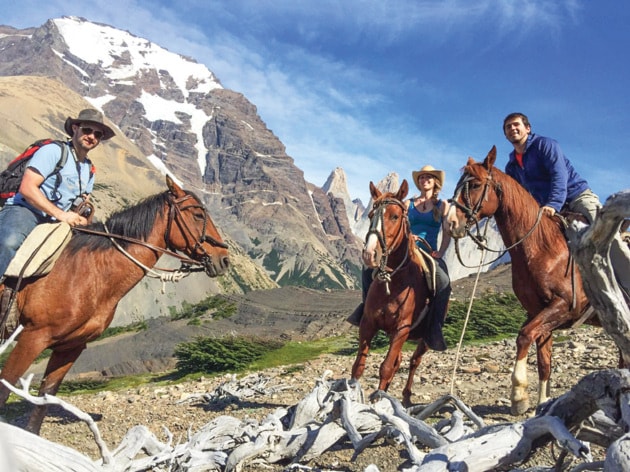The Shuswap Trail Alliance is developing an international reputation for excellence.
Jacob (Sutra) Brett, the trail alliance’s technical trail designer, and operations manager Veda Roberge returned last week from a 16-day trail adventure in Torres del Paine National Park, in Chile’s Patagonia region.
AMA Torres del Paine, a non-profit conservation organization that works within the park, invited Roberge and Brett to provide their expertise in a nine-kilometre pilot project.
The Torres del Paine are the three spectacular granite peaks that extend up to 2,500 metres above sea level and draw an increasing number of trekkers from around the world.
“Now they’re at the point of having 200,000 a year with 500 to 1,000 people per day in the peak season, just on the last Las Torres trail, and that’s not counting the horses,” says Brett. “We’ve never seen that much volume on a trail.”
Also new to Brett and Roberge was the trail’s exposure – 200-foot scree slopes (collection of broken rock fragments) into a river, a trail that in places narrows to two feet or less where people and horses are continually trying to pass each other, and an area often accompanied by sudden and very strong winds.
Brett admits to being fearful on one occasion when the horse he was riding suddenly and stubbornly stopped, determined to turn around on a very narrow part of the trail.
“The look on your face was priceless,” laughs a less-than-sympathetic Roberge.
“There are more than 200 kilometres of trail and they admit they don’t know how to fix them,” says Brett of the system that was created by range cattle many years ago and whose silty soil structure is crumbling.
Roberge says she and Brett did a lot of walking and horseback riding to cover as much territory as possible. One of the main conclusions they came to was the necessity of separating horses from hikers.
They may need some ideas and assistance, but Roberge says the people they met and worked with were amazing and dedicated.
Partners include the National Forest Corporation or CONAF, a Chilean private, non-profit organization, and Cequa, a group that goes into the field to collect a wide range of data, while AMA takes care of rehabilitation, replanting and rebuilding.
As well as the erosion caused, in part, by winds that can hit 200 km/h, Brett says the trails in Patagonia also have issues similar to those in the Shuswap, particularly in terms of the annual freshet.
He says it wasn’t just the expertise the Shuswap Trail Alliance could provide that appealed to the groups who are trying to rehabilitate and preserve the Torres del Paine trails.
“They also like our collaboration with other groups and the community and our bringing all the partners together,” he says. “Basically, they’re bringing a bunch of partners together like we do up here, with passion and concern for the future of the nation and its trail system.”
The connection between the trail alliance and AMA was made by Ross Cloutier with the Thompson Rivers University Faculty of Adventure, Tourism and Culinary Arts, one of the trail alliance’s supporting partners.
Cloutier met with AMA officials on a visit to Chile and referred the group to Shuswap Trail Alliance executive-director Phil McIntyre Paul.
“We’ve been sharing notes between our two organizations for several months now,” McIntyre Paul said. “This is really an amazing opportunity to learn from an organization that has a long history of collaborating with international partners.”
And Roberge and Brett were also a big hit with one of Chile’s most prominent national newspapers, which did a full-page story on the two trail experts.
“They’re definitely wanting us to go back and we’re in open discussions about them coming here for us to teach them and help them there,” says Roberge, noting that while the Chileans would like to have the work done as soon as possible, there is a lot of work to be done, including construction of two suspension bridges.
